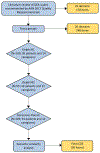Development of a core outcome set for quality of life for adults with drug-resistant epilepsy: A multistakeholder Delphi consensus study
- PMID: 36347817
- PMCID: PMC11161193
- DOI: 10.1111/epi.17461
Development of a core outcome set for quality of life for adults with drug-resistant epilepsy: A multistakeholder Delphi consensus study
Abstract
Objective: In 2017, the American Academy of Neurology (AAN) convened the AAN Quality Measurement Set working group to define the improvement and maintenance of quality of life (QOL) as a key outcome measure in epilepsy clinical practice. A core outcome set (COS), defined as an accepted, standardized set of outcomes that should be minimally measured and reported in an area of health care research and practice, has not previously been defined for QOL in adult epilepsy.
Methods: A cross-sectional Delphi consensus study was employed to attain consensus from patients and caregivers on the QOL outcomes that should be minimally measured and reported in epilepsy clinical practice. Candidate items were compiled from QOL scales recommended by the AAN 2017 Quality Measurement Set. Inclusion criteria to participate in the Delphi study were adults with drug-resistant epilepsy diagnosed by a physician, no prior diagnosis of psychogenic nonepileptic seizures or a cognitive and/or developmental disability, or caregivers of patients meeting these criteria.
Results: A total of 109 people satisfied inclusion/exclusion criteria and took part in Delphi Round 1 (patients, n = 95, 87.2%; caregivers, n = 14, 12.8%), and 55 people from Round 1 completed Round 2 (patients, n = 43, 78.2%; caregivers, n = 12, 21.8%). One hundred three people took part in the final consensus round. Consensus was attained by patients/caregivers on a set of 36 outcomes that should minimally be included in the QOL COS. Of these, 32 of the 36 outcomes (88.8%) pertained to areas outside of seizure frequency and severity.
Significance: Using patient-centered Delphi methodology, this study defines the first COS for QOL measurement in clinical practice for adults with drug-resistant epilepsy. This set highlights the diversity of factors beyond seizure frequency and severity that impact QOL in epilepsy.
Keywords: Delphi technique; core outcome set; drug-resistant epilepsy; epilepsy; patient-centered outcomes; quality of life.
© 2022 International League Against Epilepsy.
Conflict of interest statement
CONFLICT OF INTEREST
S.C. has served as a consultant for Neurelis. R.M. is the cofounder/owner of Seizure Tracker, which has received funding from Cerevel Therapeutics, Greenwich Biosciences, Marinus Pharmaceuticals, Neurelis, NeuroPace, UCB, and the Tuberous Sclerosis Alliance. J.M.S. serves as a consultant to UCB, Neurelis, Jazz, SK Life Sciences, and Novela. J.R.P. is the founder/owner of Plain Language Health. A.D.P. serves as a consultant for Greenwich Biosciences and serves on the advisory board for Neurelis. A.D.P. has received research funding from the Pediatric Epilepsy Research Foundation and the National Institutes of Health. A.D.P. performs webinar and educational development for Medscape. V.R.R. has served as a consultant for NeuroPace, manufacturer of the RNS System. None of the other authors has any conflict of interest to disclose.
Figures



Similar articles
-
Core Health Outcomes in Childhood Epilepsy (CHOICE): Development of a core outcome set using systematic review methods and a Delphi survey consensus.Epilepsia. 2019 May;60(5):857-871. doi: 10.1111/epi.14735. Epub 2019 Apr 25. Epilepsia. 2019. PMID: 31021436 Free PMC article.
-
Measuring communication as a core outcome in aphasia trials: Results of the ROMA-2 international core outcome set development meeting.Int J Lang Commun Disord. 2023 Jul-Aug;58(4):1017-1028. doi: 10.1111/1460-6984.12840. Epub 2022 Dec 30. Int J Lang Commun Disord. 2023. PMID: 36583427 Free PMC article.
-
Development of a Core Outcome Set for Clinical Trials in Non-infectious Uveitis of the Posterior Segment.Ophthalmology. 2021 Aug;128(8):1209-1221. doi: 10.1016/j.ophtha.2021.01.022. Epub 2021 Jan 28. Ophthalmology. 2021. PMID: 33515595
-
A core outcome set for childhood epilepsy treated with ketogenic diet therapy (CORE-KDT study): International parent and health professional consensus.Epilepsia. 2023 Apr;64(4):919-936. doi: 10.1111/epi.17513. Epub 2023 Feb 10. Epilepsia. 2023. PMID: 36654244 Review.
-
Core outcome measurement set for research and clinical practice in post-COVID-19 condition (long COVID) in children and young people: an international Delphi consensus study "PC-COS Children".Eur Respir J. 2024 Mar 14;63(3):2301761. doi: 10.1183/13993003.01761-2023. Print 2024 Mar. Eur Respir J. 2024. PMID: 38359962 Free PMC article. Review.
Cited by
-
Outcome measures for assessing change in children with hypermobility-associated conditions and chronic lower limb musculoskeletal pain: a Delphi survey of international health professions.Clin Rheumatol. 2025 Jul;44(7):2593-2600. doi: 10.1007/s10067-025-07504-x. Epub 2025 May 28. Clin Rheumatol. 2025. PMID: 40437322 Free PMC article. Review.
-
Usage and impact of patient-reported outcomes in epilepsy.Brain Behav. 2023 Dec;13(12):e3342. doi: 10.1002/brb3.3342. Epub 2023 Nov 23. Brain Behav. 2023. PMID: 37997564 Free PMC article.
-
Multi-omics technologies and molecular biomarkers in brain tumor-related epilepsy.CNS Neurosci Ther. 2024 Apr;30(4):e14717. doi: 10.1111/cns.14717. CNS Neurosci Ther. 2024. PMID: 38641945 Free PMC article. Review.
-
Communicating a diagnosis of Dravet syndrome to parents/caregivers: An international Delphi consensus.Epilepsia Open. 2025 Apr;10(2):450-465. doi: 10.1002/epi4.13127. Epub 2025 Feb 1. Epilepsia Open. 2025. PMID: 39891606 Free PMC article.
-
Patient-reported outcomes in epilepsy: a case study exploring their usage and impact.Glob Reg Health Technol Assess. 2024 May 3;11:108-114. doi: 10.33393/grhta.2024.3020. eCollection 2024 Jan-Dec. Glob Reg Health Technol Assess. 2024. PMID: 38715635 Free PMC article.
References
-
- Devinsky O, Penry JK. Quality of life in epilepsy: the clinician’s view. Epilepsia. 1993;34:S4–7. - PubMed
-
- Jacoby A, Snape D, Baker GA. Determinants of quality of life in people with epilepsy. Neurol Clin. 2009;27(4):843–63. - PubMed
-
- Devinsky O, Vickrey BG, Cramer J, Perrine K, Hermann B, Meador K, et al. Development of the quality of life in epilepsy inventory. Epilepsia. 1995;36(11):1089–104. - PubMed
-
- Jacoby A. Stigma, epilepsy, and quality of life. Epilepsy Behav. 2002;3(6):10–20. - PubMed
-
- Perrine K, Hermann BP, Meador KJ, Vickrey BG, Cramer JA, Hays RD, et al. The relationship of neuropsychological functioning to quality of life in epilepsy. Arch Neurol. 1995;52(10):997–1003. - PubMed

